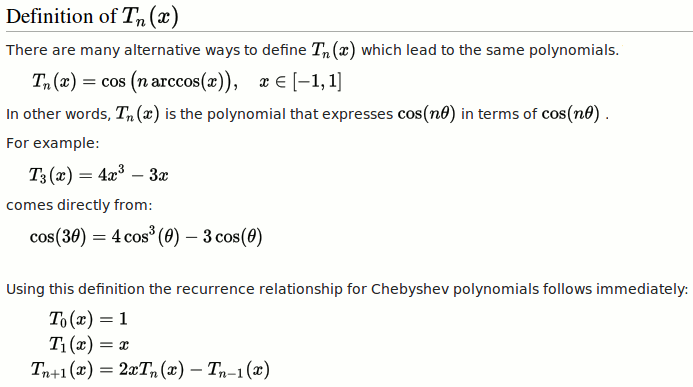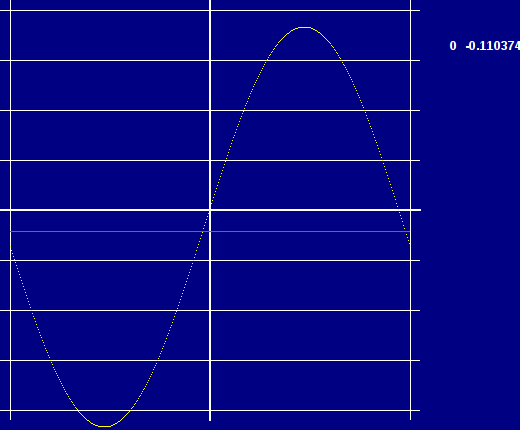
Wikipedia is helpful as-ever, with the following definitions.


Since one of the definitions of the Tchebyshev functions is as a polynomial, once you know the amplitude of each Tchebyshev term you can add the various powers of x to give a simple polynomial which will be fast to evaluate.. The first image shows in turn the Tchebyshev components. A DC term and oscillatory terms a BIT like sin/cos.

The next image shows the arbitrary target waveform, and the improving accuracy as each further term is added.

nomainwin
' use only up to first 8 Tchebyshev terms ( 0 to 7)
' synthesises a cos curve between limits
n =200
global pi: pi =4 *atn( 1)
for c =0 to 7
c( c) =0
for k =0 to n
xk =cos( ( ( 2 *k +1) /(2 *( n +1))) *pi)
if c =0 then
c( c) =c( c) +( 1 /( n +1)) *funcn( xk)
else
c( c) =c( c) +( 2 /( n +1)) *funcn( xk) *Tchebyshev( c, xk)
end if
next k
'print using( "##.####", c( c))
next c
print
WindowWidth =840
WindowHeight =460
open "Tchebyshev" for graphics_nsb as #wg
#wg "trapclose quit"
#wg "down ; fill darkblue"
#wg "color white"
for h =0 to 9
if h =4 then #wg "size 2" else #wg "size 1"
#wg "up ; goto 0 "; 10 +50 *h; " ; down ; goto 420 "; 10 +50 *h
next h
for v =0 to 2
if v =1 then #wg "size 2" else #wg "size 1"
#wg "up ; goto "; 10 +200 *v; " 0 ; down ; goto "; 10 +200 *v; " 420"
next v
for x =-1 to 1 step 0.005
print using( "##.##", x), using( "##.####",funcn( x)),
#wg "color 255 255 0 ; set "; int( ( x +1) *200 +10); " "; int( 210 -funcn( x) *50)
t =0
for c =0 to 7
t =t +c( c) *Tchebyshev( c, x)
next c
print using( "##.####", t)
#wg "color 255 0 255 ; set "; int( ( x +1) *200 +10); " "; int( 210 -t *50)
next x
#wg "color white ; backcolor darkblue"
for i =0 to 7
#wg "up ; goto 450 "; 50 +i *20
#wg "down"
#wg "\"; i; " "; using( "##.######", c( i))
next i
wait'_____________________________________________________________________
function Tchebyshev( n, x)
select case
case x >1
Tchebyshev =cosh( n *arcCosh( x))
case x <-1
Tchebyshev =cos( n *arcCosh( x))
case ( ( x >=-1) and ( x <=1))
Tchebyshev =cos( n *acs( x))
end select
end function
function cosh( x)
cosh =0.5 *( exp( x) +exp( 0 -x))
end function
function arcCosh( x)
if x >1 then arcCosh =log( x +( x^2 -1)^0.5)
end function
sub quit h$
close #wg
end
end sub
sub delay t
timer t *1000, [o]
wait
[o]
timer 0
end sub
function funcn( x)
funcn =cos( x)
'funcn4 *sin( x)^2
'funcn =exp( x) ' 1.2661 1.1302 0.2715 0.0443 is expected
'funcn =4 *x^2
'funcn =4 *sin( pi *x)
end function